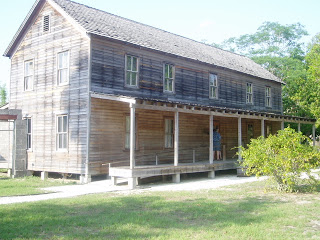 Sunday, May 20, 2007--Late in the afternoon we visited the Koreshan State Historic Site in Estero, a community just south of Fort Myers. In 1894, a group called the Koreshan Unity moved from Chicago to a 300-acre site along the Estero River, not far from where it enters the Gulf. A campground run by the Florida State Park system features this scenic river overlook.
Sunday, May 20, 2007--Late in the afternoon we visited the Koreshan State Historic Site in Estero, a community just south of Fort Myers. In 1894, a group called the Koreshan Unity moved from Chicago to a 300-acre site along the Estero River, not far from where it enters the Gulf. A campground run by the Florida State Park system features this scenic river overlook. The area is home to the Gopher Tortoise, an endangered species. This was the second one that we saw. It was dining on grass and didn't seem at all bothered by our presence.
The area is home to the Gopher Tortoise, an endangered species. This was the second one that we saw. It was dining on grass and didn't seem at all bothered by our presence. The Koreshanites created a settlement that they expected would someday become the New Jerusalem and hold 10 million people. They were attempting to restore Christianity, but they had some unusual beliefs, such as that they were already living at the inside of the universe, and that when their founder, Dr. Cyrus Teed died, he would come back to life and make all of them immortal. Koresh, by the way, is Hebrew for Cyrus, or shepherd, according to literature at the tour site. One of their improvements was to plant a wide variety of trees in the former jungle/swampland. This huge old live oak hung with Spanish moss resembled Annie Dillard's Tree with the Lights in It in the evening sun.
The Koreshanites created a settlement that they expected would someday become the New Jerusalem and hold 10 million people. They were attempting to restore Christianity, but they had some unusual beliefs, such as that they were already living at the inside of the universe, and that when their founder, Dr. Cyrus Teed died, he would come back to life and make all of them immortal. Koresh, by the way, is Hebrew for Cyrus, or shepherd, according to literature at the tour site. One of their improvements was to plant a wide variety of trees in the former jungle/swampland. This huge old live oak hung with Spanish moss resembled Annie Dillard's Tree with the Lights in It in the evening sun. This shotgun house was actually inhabited by a descendant of the colony until the 1960s. It is awaiting restoration. We were amazed to think that this group of folks moved into what was a true wilderness, infested by bugs and unfriendly plants like saw palmetto, with these high ambitions of creating a perfect society where everyone had a job and no one went without.
This shotgun house was actually inhabited by a descendant of the colony until the 1960s. It is awaiting restoration. We were amazed to think that this group of folks moved into what was a true wilderness, infested by bugs and unfriendly plants like saw palmetto, with these high ambitions of creating a perfect society where everyone had a job and no one went without.
The settlement was governed by the Planetary Court, a group of seven women who had sold their property and helped invest in the venture. They lived in this house, built in 1906. Each had a room with a window and door on the second floor; a male guardian lived in the third floor cupola room above. The house had a cistern to collect water. The settlement had an electric generator and all of the buildings had electricity as well.
 The building at right was the Art House, site of many musical events and lectures, some of them open to the public. The group was progressive in many of its social views, including support of the Suffragette movement. However, those who lived on the communal grounds had to remain celibate. This building was under restoration and not open. Its unusual knee brackets supporting the roof are a distinctive architectural feature.
The building at right was the Art House, site of many musical events and lectures, some of them open to the public. The group was progressive in many of its social views, including support of the Suffragette movement. However, those who lived on the communal grounds had to remain celibate. This building was under restoration and not open. Its unusual knee brackets supporting the roof are a distinctive architectural feature.
At left is Founder's House, the first structure built in the colony. The group operated a general store and gas station on the property well into the 1960s. The Koreshan settlement was the only stop between Fort Myers and Naples before the Tamiami Trail, now US 41 linking Tampa and Miami, was built. They sold bread from their bakery and operated other businesses. Some more research brought up the information that Dr. Teed clashed with some thugs from Fort Myers who were upset that the group practiced communal or "communist" economics. He died some two years later of related injuries.

Eventually, the colony lost believers when Dr. Teed did not return, as he had promised, after death. One of the last women to live on the site, a daughter of one of the founders, observed that after 1969, when she "saw those boys" walking on the moon, she lost her faith in the founder's belief that the center of the Universe was inside Koreshan. For us, it was an interesting and educational trip, especially when paired with the next report about Monday's safari to the winter estates of Thomas Edison and Henry Ford on what is now the Fort Myers waterfront.








No comments:
Post a Comment